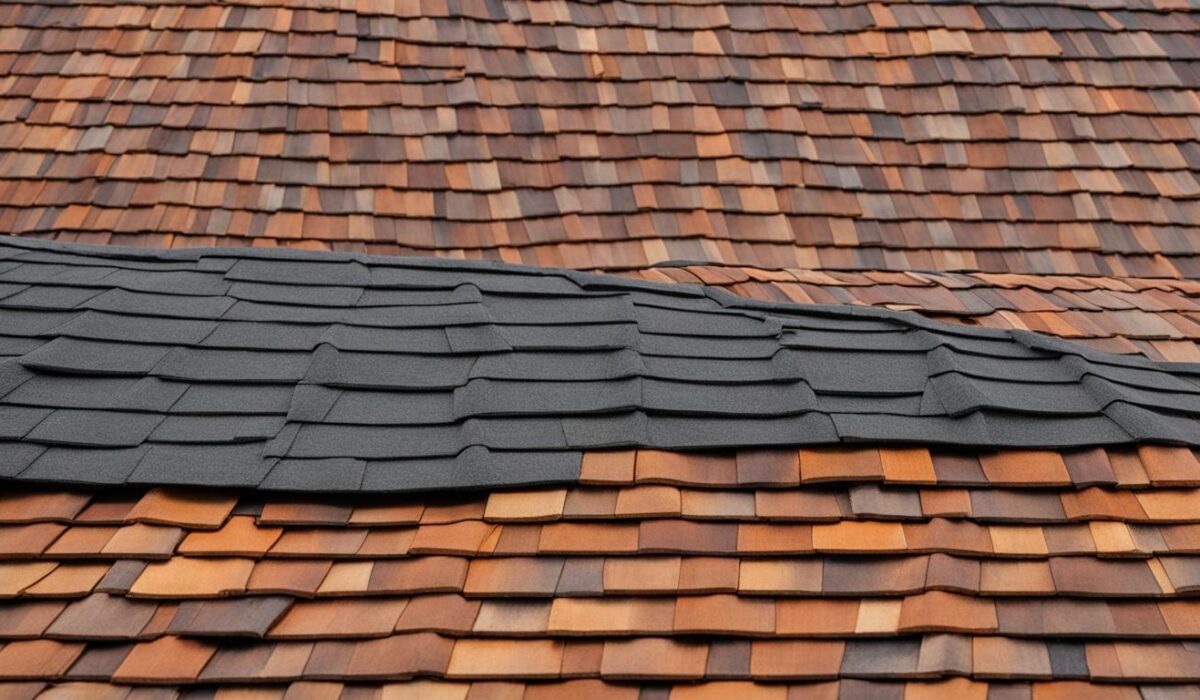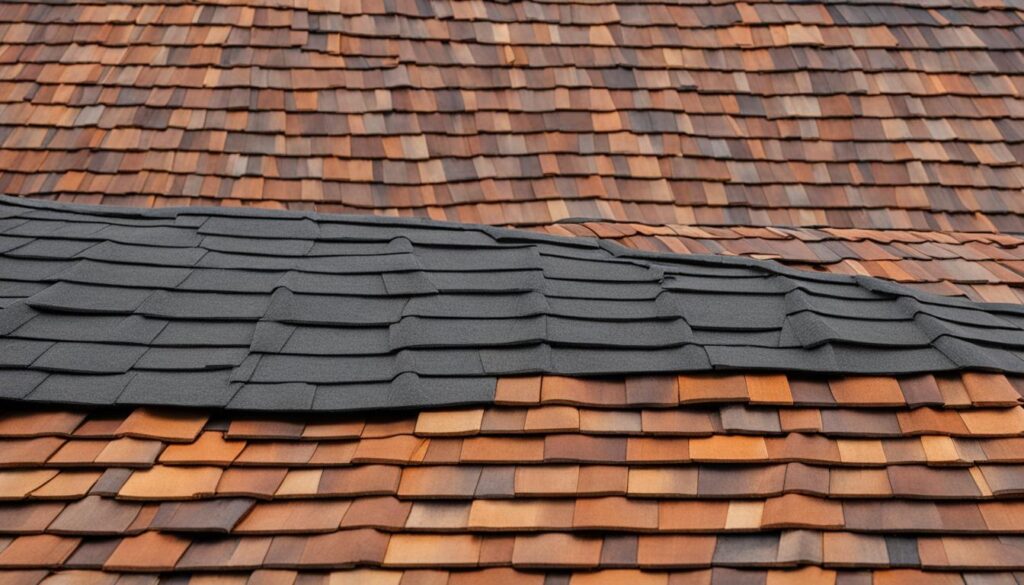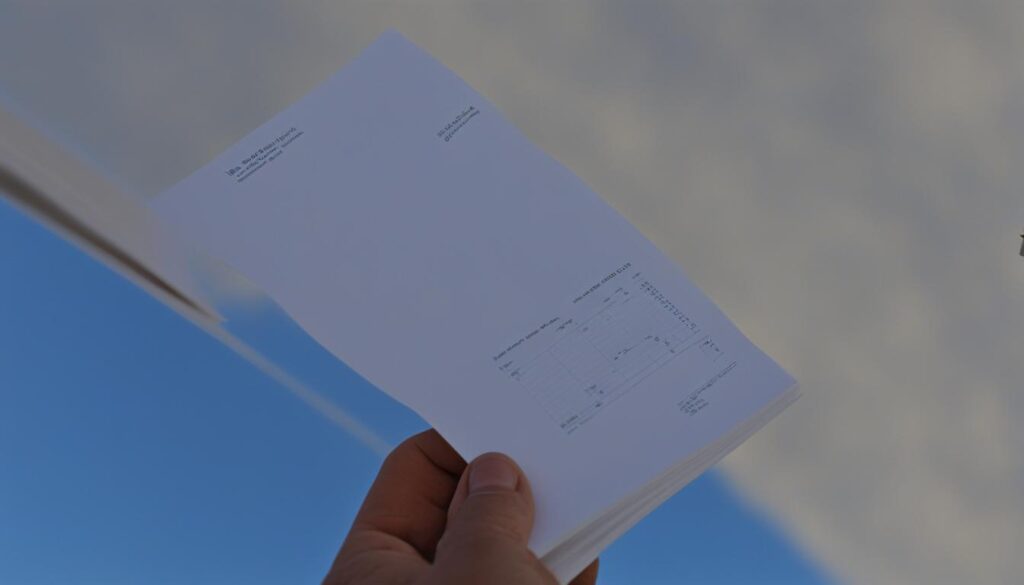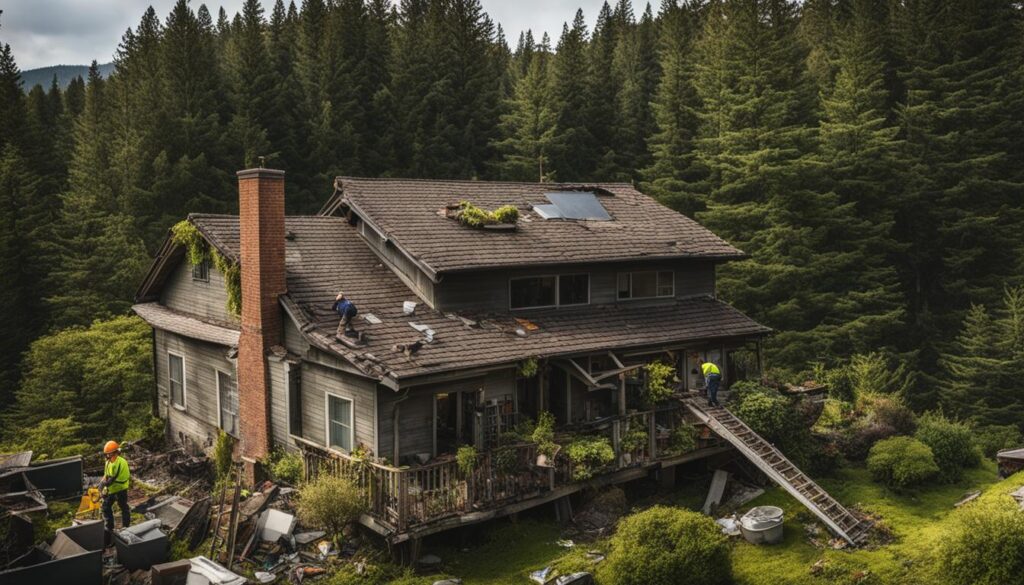The lifespan of your roof is an important consideration when it comes to maintenance and planning. Various factors can affect how long your roof will last, with one of the key factors being the type of roofing material used. Different materials have different lifespans, and understanding these lifespans can help you make informed decisions about your roof. In this guide, we will explore the lifespans of different roofing materials and the factors that can affect the longevity of your roof.
Key Takeaways:
- The lifespan of a roof depends on the type of roofing material used
- Asphalt shingles typically last 15-25 years
- Metal roofing can last 30-50 years
- Clay and concrete roofing materials can have lifespans of 50-100 years and 40-75 years, respectively
- Proper maintenance and quality installation can help prolong the lifespan of your roof
Factors Affecting Roof Lifespan
Several factors can influence the lifespan of a roof. Understanding these factors is essential for homeowners looking to maximize the longevity of their roofs and make informed decisions about roof replacement. Let’s explore some of the key factors that can affect the lifespan of a roof:
Ventilation
Proper ventilation is crucial for maintaining a healthy roof. It helps to regulate the temperature and moisture levels, preventing the buildup of excess heat and condensation. Inadequate ventilation can lead to premature deterioration, as trapped heat and moisture can cause the roofing materials to degrade faster. By ensuring proper ventilation, homeowners can extend the lifespan of their roofs.
Roof Color
The color of the roof can also impact its lifespan. Darker-colored roofs tend to absorb more heat from the sun, which can cause the roof to age faster. On the other hand, lighter-colored roofs reflect more sunlight and stay cooler, helping to prolong their lifespan. When choosing a roof color, it’s important to consider the climate and the amount of sun exposure the roof will receive.
Location
The location of a property can significantly affect the lifespan of its roof. Regions with extreme weather conditions, such as heavy snowfall, high winds, or frequent hailstorms, can put more stress on the roof and accelerate its deterioration. Additionally, properties located in areas with high levels of air pollution or saltwater exposure may also experience faster roof decay. Taking into account the specific environmental factors of a location is crucial when estimating the lifespan of a roof.
Installation
The quality of installation plays a vital role in determining the lifespan of a roof. Improper installation techniques or shortcuts can lead to premature roof failure, as the materials may not be properly secured or sealed. To ensure a long-lasting roof, it is recommended to hire professional roofers with experience and expertise in the specific roofing material being used. Skilled craftsmen follow proper installation practices, ensuring the roof is built to last.
By considering factors such as ventilation, roof color, location, and installation, homeowners can take proactive measures to extend the lifespan of their roofs and make informed decisions about roof replacement.
How to Determine the Age of Your Roof
If you’re curious about the age of your roof, there are several methods you can use to determine its installation date. One option is to contact the previous owners of your property. They may have the information you need and can provide you with valuable insights into the roof’s history. Another option is to locate the building permit for the roof installation. Building control offices usually keep records for at least 15 years, and you can request the permit information from them.
If these options aren’t feasible, you can always arrange for a professional assessment by a roofing contractor. They have the expertise to examine the materials used, installation techniques, and current condition of the roof. They can also identify any signs of damage or wear and tear, which can help them estimate the roof’s age.
Methods to Determine Roof Age:
- Contact previous owners and inquire about the installation date.
- Locate the building permit for the roof installation.
- Arrange for a professional assessment by a roofing contractor.
By using these methods, you can gain a better understanding of the age of your roof and make informed decisions regarding maintenance and potential replacements in the future.
Average Lifespan of Roofing Materials
When it comes to choosing the right roofing material for your property, understanding the average lifespan of different options is crucial. Here, we’ll explore the expected lifespans of various roofing materials, including clay tiles, asphalt shingles, metal roofing, concrete roofing, cedar shingles, natural slate, composite roofs, EPDM roof, and PVC and TPO membranes.
Roofing Material Lifespans
| Roofing Material | Average Lifespan |
|---|---|
| Clay Tiles | 20-25 years |
| Asphalt Shingles | 20-25 years |
| Metal Roofing | 30-50 years |
| Concrete Roofing | 40-75 years |
| Cedar Shingles | 20-40 years |
| Natural Slate | 50-100 years |
| Composite Roofs | 30-50 years |
| EPDM Roof | 5-15 years |
| PVC and TPO Membranes | 20-30 years |
As shown in the table above, clay tiles and asphalt shingles have a similar average lifespan of 20-25 years. Metal roofing offers a longer lifespan of 30-50 years, making it a durable option. Concrete roofing can last even longer, with an average lifespan of 40-75 years. Cedar shingles have a slightly shorter lifespan of 20-40 years, while natural slate stands out with a lifespan ranging from 50 to 100 years. Composite roofs fall within the 30-50 year range, providing a good balance of longevity and affordability.
On the other end of the spectrum, EPDM roofs have a relatively short lifespan of 5-15 years, making them better suited for temporary or budget-conscious projects. PVC and TPO membranes offer a longer lifespan of 20-30 years, making them a popular choice for commercial and residential properties that value durability.
It’s important to note that these are average lifespans and can vary based on factors such as climate, maintenance, and installation quality. Regular inspections and maintenance can help extend the lifespan of any roofing material, ensuring the longevity and structural integrity of your property.
Importance of Roof Lifespan
Understanding the lifespan of your roof is crucial for proper maintenance and long-term cost savings. Regular roof maintenance is essential in prolonging the lifespan of your roof and preventing costly repairs. By identifying potential issues early on, you can address them promptly and avoid further damage that could shorten the lifespan of your roof.
Investing in a long-lasting roof can also be highly cost-effective in the long run. While it may require a higher upfront investment, a roof with a longer lifespan can save you money on frequent replacements. By choosing durable roofing materials and proper installation, you can enjoy the benefits of a roof that will protect your property for many years to come.
The Benefits of Roof Maintenance
Regular roof maintenance helps detect and address small problems before they escalate into significant issues. It involves inspecting the roof for any signs of damage, such as cracks, leaks, or loose shingles, and taking remedial actions promptly. Additionally, routine maintenance includes clearing debris, cleaning gutters, and checking for proper ventilation.
“Proper maintenance can extend the lifespan of your roof by years and save you money in the long run.”
By keeping your roof in good condition, you can prevent leaks and water damage, which can lead to costly repairs and even structural issues. Regular inspections and maintenance also contribute to the overall durability of your roof, allowing it to withstand various weather conditions and environmental factors.
Choosing Long-Lasting Roofs
When installing a new roof or replacing an existing one, it’s important to consider the lifespan of different roofing materials. Opting for a long-lasting roof can provide peace of mind and minimize the need for future replacements. Some of the longest-lasting roofing materials include metal, clay, concrete, and natural slate.
Metal roofing, for example, can have a lifespan of 30-50 years or more, depending on the specific type of metal used. Clay tiles can last anywhere from 50 to 100 years, while concrete roofing can endure for 40-75 years. Natural slate is known for its longevity, with a lifespan of 50-100 years.
Conclusion
In conclusion, the lifespan of a roof depends on various factors, including the type of roofing material, proper maintenance, and quality installation. It is important to note that asphalt shingles typically last 15-25 years, while metal roofing can last 30-50 years.
For those looking for even longer-lasting options, clay and concrete roofing materials have longer lifespans of 50-100 years and 40-75 years, respectively. Determining the age of your roof can be done through various methods, such as contacting previous owners, locating the building permit, or arranging for a professional assessment.
Understanding the lifespan of your roof is crucial for maintenance and making informed choices about roofing materials. By knowing the expected lifespan of different roofing materials, you can plan for regular maintenance to prolong the life of your roof and avoid costly repairs. Additionally, opting for a long-lasting roof can be more cost-effective in the long run, as you won’t have to replace it as frequently.
FAQ
How long does a roof typically last?
The lifespan of a roof depends on various factors, including the type of roofing material used. Asphalt roofing, which is the most common type, lasts around 15-25 years. Three-tab shingle roofs have a lifespan of 10-20 years, while architectural/dimensional shingles can last 15-25 years. Metal roofing can last between 30 and 50 years, depending on the materials used. Clay and concrete roofing materials are known for their durability, with clay lasting 50-100 years and concrete lasting 40-75 years. Cedar shingles and shake roofs have a lifespan of 20-40 years, while natural slate can last anywhere from 50 to 100 years. Composite roofs typically last 30-50 years, while EPDM roofs have a lifespan of 5-15 years. PVC and TPO membranes offer a lifespan of 20-30 years.
What factors can influence the lifespan of a roof?
Several factors can influence the lifespan of a roof. Proper ventilation is essential in keeping the roof cool and preventing the formation of ice dams, which can cause damage. The color of the roof also plays a role, as darker roofs tend to absorb more heat, leading to faster wear and tear. The location of the property is important, particularly in areas with heavy snowfall that can hasten deterioration. The quality of installation also matters, as professional installation can extend the lifespan of the roof. Skilled craftsmen use techniques like “clean roofing” that involve the complete removal of old shingles and proper installation of new ones.
How can I determine the age of my roof?
If you want to determine the age of your roof, you have a few options. You can try contacting the previous owners of the property and ask for information about the roof’s installation date. Another option is to locate the building permit if one was required for the roof installation. Building control offices keep records for a minimum of 15 years, and you can request the permit information. If these options are not feasible, you can also arrange for a professional assessment by a roofing contractor. They can examine the materials used, installation techniques, current condition, and any damage to estimate the roof’s age.
What is the average lifespan of different roofing materials?
The average lifespan of different roofing materials can vary. Clay and asphalt shingles, which are common choices, have a lifespan of around 20-25 years. Metal roofing can last up to 40 years, while concrete roofing can last up to 75 years. Cedar shingles have a lifespan of 20-40 years, natural slate can last 50-100 years, and composite roofs have a lifespan of 30-50 years. EPDM roofs typically last 5-15 years, while PVC and TPO membranes offer a lifespan of 20-30 years.
Why is it important to understand the lifespan of your roof?
Understanding the lifespan of your roof is important for proper maintenance and planning. Regular maintenance can help prolong the lifespan of your roof and prevent costly repairs. Knowing the expected lifespan of different roofing materials can also help you make informed decisions when it comes to choosing the best roofing material for your property. Opting for a long-lasting roof can be more cost-effective in the long run, as you won’t have to replace it as frequently.




